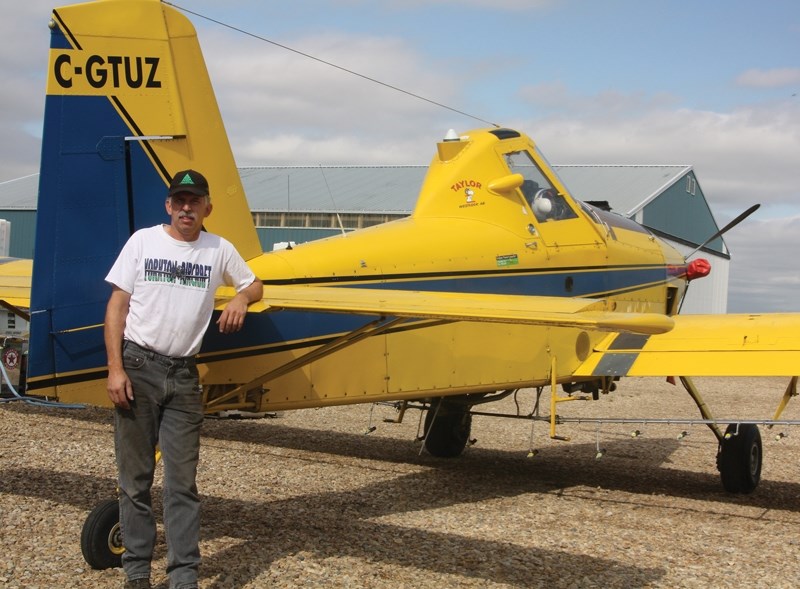Keith Taylor is an area farmer, but it’s not his farming operation that has him concerned about Alberta PowerLine’s Fort McMurray West 500-kV Transmission Project.
Taylor is an aerial crop sprayer and with many of his customers potentially affected by the proposed east route of the power line, so too is his business.
The fate of the $1.49 billion project, which will connect a Leduc County substation to Fort McMurray, currently rests in the hands of the Alberta Utilities Commission (AUC), the province’s independent utility regulator.
AUC will determine if the power line takes an east route, through Westlock County, or a west route through the County of Barrhead.
In all likelihood Taylor said on affected properties it would likely mean not being able to completely spray fields, which means lost business for him.
While Taylor’s company, Taylor Aviation, would take a hit from either route, he says the east route through Westlock County stands significantly impact him.
The proposed route would enter Westlock County west of Busby and cross Highway 18 west of Westlock before banking east between Westlock and Pibroch before heading north again on the east side of Highway 44.
“I don’t spray all those fields, but there’s a good portion that are affected by those power lines,” he said.
Piloting around such lines is no easy task.
“Particularly with the high power line, like this one, we have to keep further away … I’m operating at 10 feet off the crop,” Taylor said.
“If I’ve got to come up over a power line, I’ve got to leave the crop that much sooner, or I have to operate parallel. Operating parallel isn’t always the efficient way to spray a field.”
Aside from efficiency there’s the sheer danger.
“The biggest danger with the power line is we’re spraying at 120-150 m.p.h., so you’re approaching the wire at that speed,” Taylor explained.
“Not always, but more often than not, I can’t see those wires.”
Taylor knows all too well about the dangers of flying near power lines.
In September 2012 Taylor was almost killed when his plane clipped a power line near Jarvie while spraying a crop.
“We had a tangle with a power line in 2012 that didn’t end very well,” he said.
“That was just a simple guard wire on top. I didn’t actually break the power line, I broke the post, but I barely survived that.”
Taylor said it’s tough to gauge just how much or how little the power line would affect his business, but said a number of his regular clients are facing large structures on or near their fields meaning piloting his planes in those areas is too dangerous.
“It’s probably not going to terminate any of the customers, but it’s going to severely restrict how well we do the fields,” he explained.
“I can’t put a number on it. It varies, but there’s no question it restricts the acres that are going to be applied and it’s going to be a detriment to the quality of the application.”
AUC will base its decision off of the outcome of a hearing process, which will allow affected residents along both of the affected routes to voice their concerns.
The hearing, a process AUC likens to a court proceeding, is slated to start Sept. 19 in Edmonton.
Taylor said he’s already filed written evidence that the panel will review in hopes of having the commission select the west route over the east route through Westlock.
While he’s unsure what, if any, impact his evidence will have on the commission, Taylor said he’s pleased AUC is allowing him the opportunity to participate.
“It’s good. Whether that has any bearing on anything remains to be seen. Hopefully the panel takes it into consideration. That’s the best I can hope for.”
AUC spokesperson Jim Law said the purpose of the hearing is to allow anyone who would be affected by the proposed power line to speak up.
“It’s really important we hear from people directly because it does directly have potential to impact their lives and their livelihood and that’s one of the reason the process is so through and so formal,” Law explained.
Although any property owner close enough in proximity to the proposed line is automatically allowed to participate, Law said the process takes into account other ways the line can impact people.
“There’s kind of a distance, and if you’re within that distance, we generally consider you to be affected,” Law said.
“If you think there are other impacts like if you held a lease, if you were conducting an activity, etcetera, there’s still room for participation.”
Taylor operates out of a private airstrip on his own land and sprays farms within a 40-kilometre radius, reaching from Busby to Athabasca and from Neerlandia to Thorhild County.
Taylor spays fungicide in the spring and for crop desiccation in the fall.
Ultimately, Taylor says he’s hopeful AUC will pick the west route.
“I would hope it goes the west route … for me. I understand the farmers and it affects farmers over there, too,” he said.
“There’s going to be winners and losers either way.”
The hearing gets going Sept. 19 and is expected to wrap up by late October. Once the hearing wraps up, AUC has 90 days to make a decision.
It was initially expected to get underway June 6, but was delayed to the For McMurray wildfire in May.



